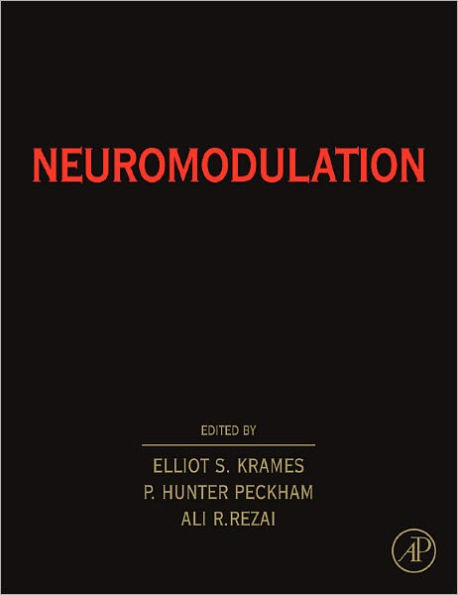Neuromodulation
Neuromodulation will be the first comprehensive and in-depth reference textbook covering all aspects of the rapidly growing field of neuromodulation. This book provides a complete discussion of the fundamental principles of neuromodulation and therapies applied to the brain, spinal cord, peripheral nerves, autonomic nerves and various organs. The textbook is highly structured and organized into overarching sections that cover chronic pain, movement disorders, psychiatric disorders, epilepsy, functional electrical stimulation, cardiac, gastrointestinal, genitourinary and organ neuromodulation. The fundamental principles of electricity and infusion, neural tissue interface, biomedical engineering, neuromodulation devices, basic science, neuroanatomy, neurophysiology, imaging and mechanisms are emphasized. In addition to providing details pertaining to the state-of-the-art current practice, innovative and emerging applications are discussed in specific chapters. Finally, the textbook provides specific chapters focusing on the technical aspects of the various neuromodulation procedures as well as technical specifications of various implantable devices. All of the contributors to Neuromodulation represent leading experts in the field. The editors are internationally renowned in their respective fields of neuromodulation, pain management, functional neurosurgery and biomedical engineering. Neuromodulation will be the first and foremost authoritative text on neuromodulation therapies and will establish the gold standard that defines the field for years to come.Key Features - The first comprehensive reference on the emerging field of Neuromodulation - Editors and authors include all leading figures in the field, and the leaders of the International Neuromodulation Society - Over 90 chapters on topics ranging from a layout of the fundamentals (e.g. neuroanatomy, plasticity, bioelectrical effects, infusion therapies), solutions for the biomedical engineering challenges (e.g. materials, how to preserve normal function etc.), to a rundown of the existing applications and their future promise - Over 1200 pages in splendid full color, richly illustrated - Important areas of application include: control of chronic paindelivery of drugs to the nervous system via implanted devicescontrol of epilepsy, Parkinson, etc.functional restoration, e.g. visual, auditory, restoration after stroke, restoration of motor function after traumatic eventsstimulation of body organs via neural devices (incl. the heart, abdominal organs, genitourinary organs)overview over newly emerging fields - control of obesity, blood pressure, tinnitus, brain injury, neurodegenerative diseases, brain-machine interfaces
1141905205
Neuromodulation
Neuromodulation will be the first comprehensive and in-depth reference textbook covering all aspects of the rapidly growing field of neuromodulation. This book provides a complete discussion of the fundamental principles of neuromodulation and therapies applied to the brain, spinal cord, peripheral nerves, autonomic nerves and various organs. The textbook is highly structured and organized into overarching sections that cover chronic pain, movement disorders, psychiatric disorders, epilepsy, functional electrical stimulation, cardiac, gastrointestinal, genitourinary and organ neuromodulation. The fundamental principles of electricity and infusion, neural tissue interface, biomedical engineering, neuromodulation devices, basic science, neuroanatomy, neurophysiology, imaging and mechanisms are emphasized. In addition to providing details pertaining to the state-of-the-art current practice, innovative and emerging applications are discussed in specific chapters. Finally, the textbook provides specific chapters focusing on the technical aspects of the various neuromodulation procedures as well as technical specifications of various implantable devices. All of the contributors to Neuromodulation represent leading experts in the field. The editors are internationally renowned in their respective fields of neuromodulation, pain management, functional neurosurgery and biomedical engineering. Neuromodulation will be the first and foremost authoritative text on neuromodulation therapies and will establish the gold standard that defines the field for years to come.Key Features - The first comprehensive reference on the emerging field of Neuromodulation - Editors and authors include all leading figures in the field, and the leaders of the International Neuromodulation Society - Over 90 chapters on topics ranging from a layout of the fundamentals (e.g. neuroanatomy, plasticity, bioelectrical effects, infusion therapies), solutions for the biomedical engineering challenges (e.g. materials, how to preserve normal function etc.), to a rundown of the existing applications and their future promise - Over 1200 pages in splendid full color, richly illustrated - Important areas of application include: control of chronic paindelivery of drugs to the nervous system via implanted devicescontrol of epilepsy, Parkinson, etc.functional restoration, e.g. visual, auditory, restoration after stroke, restoration of motor function after traumatic eventsstimulation of body organs via neural devices (incl. the heart, abdominal organs, genitourinary organs)overview over newly emerging fields - control of obesity, blood pressure, tinnitus, brain injury, neurodegenerative diseases, brain-machine interfaces
540.0
In Stock
5
1

Neuromodulation
1088
Neuromodulation
1088
540.0
In Stock

Product Details
| ISBN-13: | 9780080921396 |
|---|---|
| Publisher: | Elsevier Science & Technology Books |
| Publication date: | 05/05/2009 |
| Sold by: | Barnes & Noble |
| Format: | eBook |
| Pages: | 1088 |
| File size: | 19 MB |
| Note: | This product may take a few minutes to download. |
About the Author
What People are Saying About This
From the B&N Reads Blog
